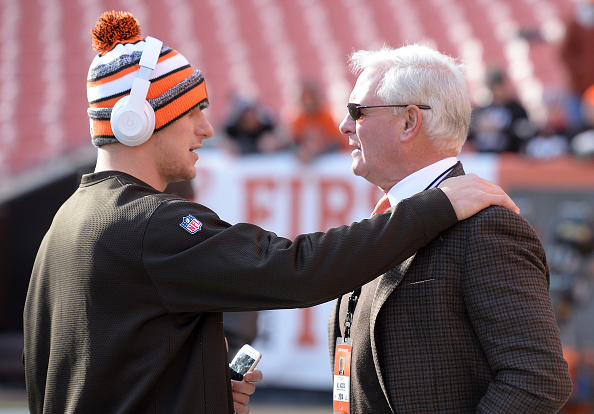Once again, the Browns have finished a losing season in a tailspin, dropping their last five games. They led the AFC North as late as November 16, but now the rest of the division is headed for the playoffs, and the Browns are headed for another tumultuous off-season.
Unlike the past two years, the head coach and general manager will stay on, according to owner Jimmy Haslam. The new Mike Pettine/Ray Farmer regime produced a three-game improvement over 2013, which ended with the scapegoating of rookie head coach Rob Chudzinski and — after a prolonged search for a successor — the eventual firing of CEO Joe Banner and his henchman, GM Mike Lombardi.
The sole rationale Haslam provided for Chud’s firing was this:
What we would say is that it’s really important that we show improvement during the course of the season. Specifically, we talked about, I believe if you look back at the quote, we needed to be better in the last three games than we were the first three games. As the season developed and what was a really nice start and as we got later into the season, it was our feeling that as a team we were not getting better. Yes, we had a young team, but I think if we’d reflect on it we would all say, ‘A young team should get better,’ and we simply didn’t feel like that was happening.
But that was a year ago. So does this 7-9 season, ending as it did with some serious skid marks, represent substantial progress and cause for hope? That’s certainly debatable, but history can provide some context.
Ten other times in NFL history, a team followed up a 4-12 season by going 7-9. So what happened next? Their combined records the next season were 66-93-1, which means the average record for a team that went 7-9 the previous year and 4-12 before that is just 7-9. And that’s rounding up.
Here are those ten teams, most recent first (* = team changed coaches during or between the preceding 4-12 and 7-9 seasons, as the Browns did):
- 2014 Lions, 11-5 (wildcard team with new coach and established QB)
- *2013 Buccaneers, 4-12 (Greg Schiano’s second-year regression got him the boot)
- 2007 49ers, 5-11 (four different QBs started games)
- 2004 Bears, 5-11 (also had four starters in Lovie Smith’s first year)
- 2002 Falcons, 9-6-1 (won a wildcard game in Michael Vick‘s first full season)
- *1997 Cardinals, 4-12 (turned to rookie QB Jake Plummer from mid-season on)
- *1996 Rams, 6-10 (Rich Brooks’ second and last season as a head coach)
- 1994 Cardinals, 8-8 (Buddy Ryan took over for Joe Bugel and lasted just two years)
- *1990 Lions, 6-10 (Wayne Fontes and Barry Sanders would have better and worse seasons)
- 1980 Chiefs, 8-8 (a middling year in the middling Marv Levy era).
The takeaway is just this: a losing team that improves by three wins doesn’t necessarily keep on improving. In fact, it usually stays a losing team. Even if it’s not the Browns.
 |
| Johnny Manziel and Jimmy Haslam confer before the Colts game. (Jason Miller/Getty) |
